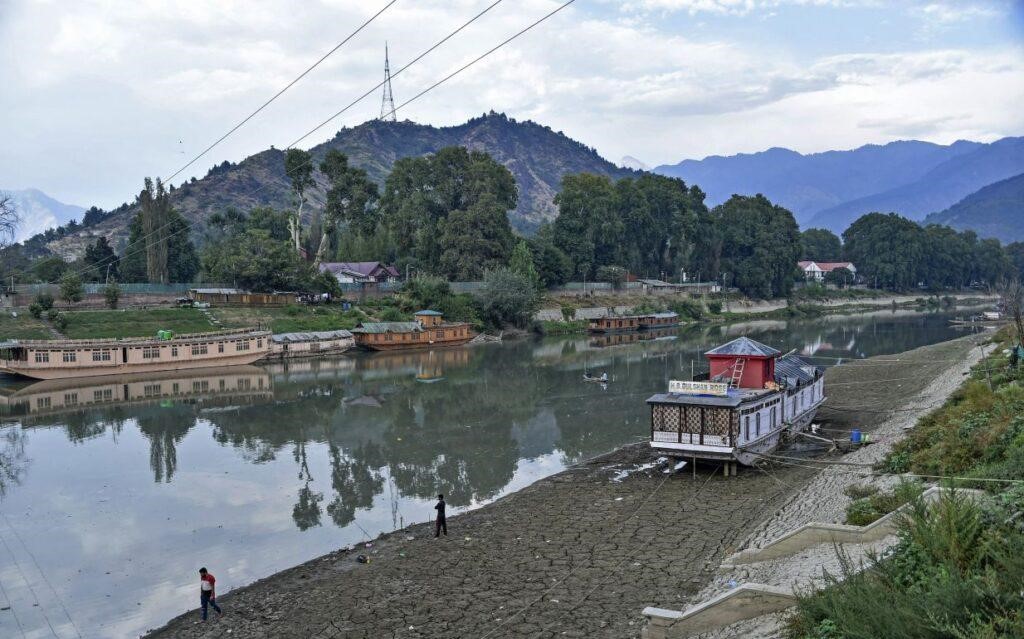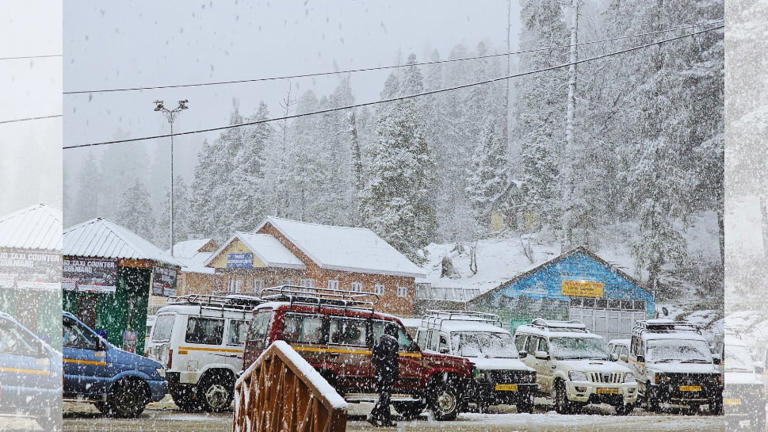A Parched Paradise
By: Javid Amin
Srinagar, India – While much of India is drenched in the annual monsoon deluge, a starkly different reality unfolds in the Kashmir Valley. This Himalayan paradise, renowned for its pristine lakes and verdant landscapes, is grappling with an unprecedented water crisis. A silent drought has crept into the region, casting a long shadow over its people, agriculture, and ecology.
A Symphony of Silence The usual symphony of rain that characterizes Kashmir’s monsoon season has been replaced by an eerie silence. The once-full rivers and streams, lifeblood of the valley, now trickle along, their beds exposed in many stretches. Lakes, like Dal and Wular, have shrunk dramatically, their once vibrant waters replaced by vast expanses of mud and weeds.
The implications are far-reaching. Farmers, the backbone of Kashmir’s economy, are staring at a bleak future. Rice fields, the valley’s green gold, are withering under the relentless sun. Orchards, renowned for their fruit, are bearing fewer and smaller yields. The crisis has also impacted the region’s famed tourism industry, as once picturesque landscapes are now marred by the scars of water scarcity.
A Perfect Storm The causes of this water crisis are complex and intertwined. Climate change, with its unpredictable weather patterns, is undoubtedly a major culprit. The region’s glaciers, once considered reliable water reservoirs, are receding at an alarming rate. This, coupled with changing rainfall patterns, has disrupted the delicate hydrological balance.
Moreover, the valley’s burgeoning population and rapid urbanization have increased water demand, putting immense pressure on existing resources. Unsustainable water extraction practices, including the proliferation of borewells, have exacerbated the situation.
A Cry for Help The people of Kashmir are united in their distress. Water scarcity has become a daily struggle. Households are rationing water, with women and children bearing the brunt of the burden. Schools and hospitals are facing challenges in maintaining basic hygiene.
Local authorities are scrambling to respond. Water tankers are being deployed to affected areas, but the demand far exceeds supply. Desperate measures like cloud seeding are being explored, though their efficacy in this region remains uncertain.
A Call to Action Addressing the water crisis in Kashmir requires a multi-faceted approach. Immediate steps include:
- Water Conservation: Implementing strict water-saving measures in households, agriculture, and industries.
- Rainwater Harvesting: Promoting the collection and storage of rainwater for various uses.
- Reforestation: Increasing forest cover to improve water retention and recharge groundwater.
- Sustainable Agriculture: Adopting water-efficient farming practices.
- Infrastructure Development: Investing in modern water supply and treatment facilities.
However, long-term solutions demand a comprehensive understanding of the region’s hydrological system and the impact of climate change. Research and data-driven decision-making are crucial for developing sustainable strategies.
A Hopeful Future While the situation is dire, there is hope. Kashmir’s people have a deep-rooted connection to water and a rich cultural heritage of water conservation. By working together, the community, government, and experts can find a way to overcome this crisis and build a water-secure future for the valley.
It is imperative that the world pays attention to Kashmir’s plight. This is not just a local issue but a global challenge that demands collective action.
The Human Cost of Kashmir’s Water Crisis
The water crisis in Kashmir is not merely a statistical anomaly or an environmental challenge; it is a profound human tragedy. The impact on the lives of ordinary people is immense, far-reaching, and often invisible.
A Daily Struggle For millions of Kashmiris, access to clean water is a daily ordeal. Women and girls, traditionally the primary water carriers, spend hours each day fetching water from distant sources. This arduous task often cuts into their education and other essential activities, perpetuating a cycle of poverty and inequality.
The health implications are severe. Waterborne diseases like diarrhea, cholera, and typhoid are on the rise as people resort to consuming contaminated water. Children are particularly vulnerable, with malnutrition and stunted growth becoming prevalent in many areas.
Economic Fallout Beyond the health crisis, the water scarcity is crippling the region’s economy. Agriculture, the backbone of Kashmir’s economy, is facing a severe downturn. Farmers are forced to reduce crop yields or abandon their fields altogether, leading to income loss and food insecurity.
The tourism industry, a major source of revenue, is also suffering. The once pristine lakes and rivers, key attractions for visitors, are now a shadow of their former glory. This decline in tourism has a ripple effect on the local economy, affecting businesses, transportation, and hospitality.
A Social Crisis The water crisis is exacerbating social tensions. Conflicts over water resources are on the rise, pitting neighbors against each other. The psychological toll of water scarcity is immense, leading to stress, anxiety, and even depression.
Moreover, the crisis is disproportionately affecting marginalized communities, including women, children, and the elderly. They are often the last to receive water and the first to bear the consequences of shortages.
A Call for Justice The water crisis in Kashmir is not merely a natural disaster; it is a crisis of governance and equity. The government’s failure to provide adequate water infrastructure and to address the root causes of the problem is a grave injustice.
The people of Kashmir deserve access to clean, safe water as a fundamental human right. It is time for the authorities to prioritize water management, invest in sustainable solutions, and ensure that every citizen has access to this essential resource.
The world must also stand in solidarity with the people of Kashmir. International support is crucial in addressing the water crisis and building resilience.
A Path Forward: Revitalizing Kashmir’s Water Lifeline
The water crisis in Kashmir demands a comprehensive and sustainable solution. This requires a convergence of efforts from government, civil society, and the community.
Prioritizing Water Governance
- Decentralized Management: Empowering local communities to manage water resources can lead to more equitable distribution and efficient use.
- Transparent Governance: Ensuring transparency in water allocation and usage is crucial to building trust between the government and the people.
- Capacity Building: Investing in training for water management professionals is essential for effective governance.
Investing in Water Infrastructure
- Modernization: Upgrading water supply and distribution systems to reduce losses and improve efficiency.
- Rainwater Harvesting: Promoting rainwater harvesting at both the household and community levels.
- Wastewater Treatment: Implementing effective wastewater treatment to prevent water pollution and reuse treated water for non-potable purposes.
Sustainable Agriculture
- Water-Efficient Practices: Encouraging farmers to adopt water-saving techniques like drip irrigation and rainwater harvesting.
- Diversification: Promoting cultivation of drought-resistant crops to reduce water dependency.
- Support for Farmers: Providing financial incentives and technical assistance to farmers to transition to sustainable practices.
Community Empowerment
- Awareness Campaigns: Educating the public about the importance of water conservation and efficient use.
- Water User Associations: Forming community-based organizations to manage water resources collectively.
- Women’s Empowerment: Involving women in water management decision-making to ensure their needs and perspectives are considered.
Climate Resilience
- Early Warning Systems: Developing robust early warning systems to predict and prepare for water shortages.
- Ecosystem Restoration: Protecting and restoring wetlands, forests, and other natural water bodies to enhance water retention.
- Research and Innovation: Investing in research to develop innovative water management solutions.
International Cooperation
- Knowledge Sharing: Collaborating with other regions facing similar challenges to share best practices and technologies.
- Financial Assistance: Seeking international support for water infrastructure development and climate adaptation.
The path forward is challenging but not insurmountable. By adopting a holistic approach that addresses the social, economic, and environmental dimensions of the water crisis, Kashmir can reclaim its status as a water-rich paradise.


